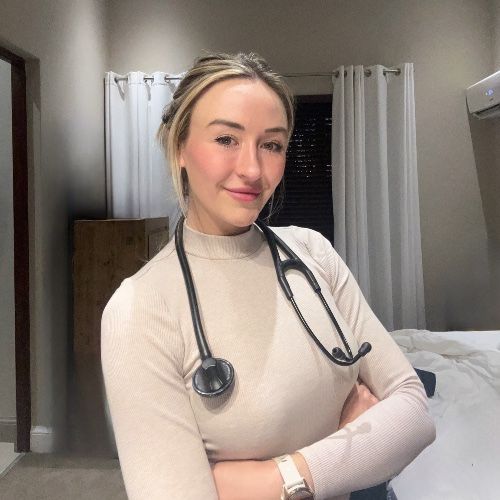From Bite to Brain: Revealing Rabies
This episode pits man’s best friend against one of man’s deadliest foes—rabies doesn’t play fetch nor does it leave many unscathed. Ruan speaks to one health champion and ID friend to many, Professor Lucille Blumberg, and they talk about the virus that turns loyal companions into lethal threats. How to diagnose it, how it's managed and most importantly how to prevent it.
About our Guest:
Professor Lucille Blumberg, MB BCH MMed (Clin Micro) ID (SA) FFTM (RCP Glasgow, travel medicine) DTM&H DOH DCH D.Sc. (Med) honoris.
She is a highly respected infectious diseases specialist and medical microbiologist, hailing from Johannesburg, who sits on many national and international expert groups. Her contribution to keeping the public safe from infectious disease has been hailed as the epitome of sustainable, groundbreaking research. She has honorary appointments at the National Institute for Communicable Diseases (NICD), the Universities of Stellenbosch (Medical Microbiology) and University of Pretoria (Faculty of Veterinary Sciences), South Africa. Her focus is on outbreak prevention and response, emerging diseases, travel-related infections, the viral haemorrhagic fevers, malaria and zoonosis, especially rabies.
She is the current chair of the Strategic Advisory Group for Infectious Hazards for the WHO Emergencies Programme and a member of the scientific advisory group for the WHO Neglected Tropical Diseases programme. She is a longstanding member of the National Rabies Advisory Group in South Africa and is the former chair of the South African Malaria Elimination Committee (SAMEC). Prof Blumberg has been involved in the prevention, detection and response to several communicable disease outbreaks, including cholera, typhoid, rabies, the Viral Haemorrhagic Fevers (Lujo, Rift Valley fever, Ebola), influenza (pandemic A H1N1, and Avian Influenza A H5N2) and diphtheria.
Her special interests are malaria, rabies, other zoonoses, East African Trypanosomiasis, travel and tropical medicine and border health issues. She has worked with Right to Care as a Technical Scientific Advisor since 2021. She has recently been appointed to the editorial board of the Southern African Journal of Infectious Diseases. Other editorial positions include being African Advisor for the International Journal of Travel Medicine since 2018, and one of three editors for the International Journal of Infectious Diseases since 2017. During the COVID-19 pandemic, she established DATCOV, a national surveillance system for patients with COVID-19 who were hospitalised.
WE'D LOVE YOUR FEEDBACK ON THIS EPISODE –
Visit the Microbe Mail website to sign up for updates
Follow on:
Instagram: Microbe_Mail
X/Twitter: @microbemail
Facebook: MicrobeMail
Tiktok: @microbe.mail
Watch this episode on our new YouTube channel: Microbe Mail
E-mail us: mail.microbe@gmail.com
Transcript
Ruan Marais:
mankind still claims lives in:Welcome to Microbe Mail. It's, uh, great to have you on the show. Can you please tell the listeners a little bit about yourself?
Lucille Blumberg:
Thanks very much. Uh, it's [:So, I'm an infectious disease specialist and a clinical microbiologist, and also I have a post at the veterinary faculty at the University of Pretoria. So, I think it brings, uh, 'One Health' together, which is really important for, for rabies prevention and response.
Ruan Marais:
Oh, fantastic. That's gonna be a great episode.
So, as usual, we have a few reminders before we head into the content of today's episode. Uh, remember to sign up for updates on your podcast player of choice. Give us a five star rating on your pod player. Follow us on social media and interact with us on Spotify q and a, on social media or via email. We love hearing from you and getting your feedback on our episodes.
and friends. Microbe Mail is [:Lucille Blumberg:
It's a viral infection as, uh, you mentioned it's, uh, causes a fatal encephalitis of the brain in both animals and, uh, humans. And it's transmitted by contact between infected animals and, uh, exposed humans.
Ruan Marais:
Ah, very important. I, I think, you know, that leads to, to really the, the question of what the prevalence is and distribution of rabies in South Africa. You know, how does, how does it affect our populace?
Lucille Blumberg:
irs and they transmit rabies [:So, we don't have good figures overall, about 55,000 cases a year in the world, most of them now in Africa, and in South Africa, probably about 10, 15 laboratory confirmed cases a year. It's probably the tip of the [00:04:00] iceberg for most places.
Ruan Marais:
Wow, that is, uh, quite scary. And I mean, I imagine with, uh, with the burden being particularly, uh, severe in, in rural areas and the, the cold chain of getting a, a brain biopsy or sample back to, to a lab that can test it really makes it difficult to diagnose.
But, uh, yeah. So, so to give the listener a bit of context, um, can you maybe walk, walk us through the virus lifecycle and how it spreads through the body? How, how does a bite become an encephalitis?
Lucille Blumberg:
So, there has to be a break in the skin. Uh, the virus cannot be transmitted through intact skin. So, the virus is in the saliva of the infected animal.
s the skin and saliva is uh, [:The virus will multiply locally and enter a peripheral nerve. And then over a period of time, and it can be as little as seven days, uh, if the bite's on the face, the, uh, virus will move towards, uh, the brain. And during that time, there are no symptoms and there are no tests that, uh, can give you any information about whether the virus was transmitted during that encounter.
ts saliva or, other systems. [:I think they've been, well, less than a handful of survivors, often with neurological sequelae. And, uh, it's really one of the very few diseases that's, uh, almost the only one that's, uh, when you know you've got a diagnosis of rabies, uh, it's, uh, it's really hopeless and so sad.
Ruan Marais:
Yeah, no. So I think what the listeners might be really interested in is, you know, so after that bite has occurred or the lick of an open skin, how long does it take for that whole process to, to occur? You know, on average, you know, what's, what's the range that we are looking at?
Lucille Blumberg:
y well innervated areas, so, [:So variable, but 10 to 14 on average becomes difficult because patients want to know, or people want to know once they've been written and perhaps they haven't received correct post-exposure prophylaxis. You know, when are they safe or you know, when can they relax? It's a very difficult time for them.
Ruan Marais:
Yeah, no, I mean, with the two year window, that's, that's then very difficult to tell anyone, you know, you are, you are in the clear That's, that's tough.
Lucille Blumberg:
s likely they are to develop [:Ruan Marais:
Mm-hmm.
Lucille Blumberg:
But, uh, as I mentioned, there are no tests before they develop symptoms to give any idea about what is going to happen.
Ruan Marais:
With there being no tests, I guess, are there any potentially early symptoms that particularly, you know, clinicians seeing a patient in the EC or, or a, a GP might need to look out for where it would, you know, ring alarm bells?
Lucille Blumberg:
Yeah, I think let's just clarify that there are no tests before symptoms develop one symptoms develop.
Um, there are several tests that can be used. Um, they're not a hundred percent sensitive, but certainly one would, um, one would do them to try and get an early diagnosis, an idea of, you know, where this patient's going. So the first symptoms often pain at the oRIGinal bite site. It's a sort of hyperesthesia.
d they have forgotten about, [:Now remember, there's a big differential diagnosis of these patients. So, clearly a history of being exposed, bitten, having contact with a potentially rabid animal is very important. But in the case of children, you know, they, uh, by the time they present, they're quite ill. They didn't tell their parents, or no one remembers, the bite is healed.
can occur anywhere, animals [:So hyperesthesia is first, headache, fever, and then, uh, it may vary. Classical symptoms are hydrophobia, so there's a fear of water. If you put the tap on or you give the patient a, a glass of water, they will be very fearful. They can't swallow because of spasm of the esophagus. They may have increased salivation, um, they may have spasms. In between the spasms, they're awake and they will tell you how fRIGhtened they are.
, instability, so high blood [:If they have supportive care, uh, in some places they could be intubated and ventilated, although this is very uncommon, unusual in, uh, resource limited areas.
You know, they may just continue with, uh, a similar state, but they, they will die. It's, it's really quite scary. In the paralytic type of rabies, uh, as opposed to the, uh, furious type, they may present exactly like polio or Guillain Barre, uh, where they appear to have weakness, paralysis of the limbs.
So, it's very difficult unless you've got a good history and actually, unless you've seen cases before, um, to always consider rabies.
But [:Ruan Marais:
Yeah, and particularly with reference to the travel history 'cause I mean, there there are, there's such a diverse list of, of encephalitides depending on where the person might have traveled from. So, you know, very important.
Lucille Blumberg:
Yeah.
It's, you know, it's not always travel, it's, it's just what they have in that area.
Ruan Marais:
Hmm.
Lucille Blumberg:
eas in rabies, they're often [:Uh, encephalitis from other causes, meningitis, often, there's, uh, quite a depressed level of consciousness, rightht? Quite early on. Drug overdoses, strychnine poisoning, tetanus, I think is, is, is very important. Remember, it also may follow a dog bite.
And then we get something called 'pseudo rabies'. So patients are, uh, it's often an adult.
f the differential diagnosis.[:Ruan Marais:
Mm-hmm.
Lucille Blumberg:
But there's, there's often the clue. It's very quick.
Ruan Marais:
Mm-hmm.
Lucille Blumberg:
Um, so let's, let's reserve that for specific cases.
Ruan Marais:
Yes. So I, I think the, the next really important thing to discuss is, um, animals that can transmit rabies and, um, how people can avoid exposures in particularly.
Lucille Blumberg:
Well, any animal that's infected can transmit rabies.
virus and then transmit it. [:In South Africa, in Africa, in Asia, the dog is the most important, but let's not forget uh,
The cats. So domestic or, uh, wild cats, mongoose and, uh, related. Um, and then livestock, you know, cows, sheep, goats can also be infected. Um, and we see that in, in more rural settings. And, uh, farmers in particular exposed. Don't forget bats. We are learning a lot more about rabies and bats. If you go to the Americas, bats are really important for transmitting classical rabies virus.
transmission and often it's [:But overwhelmingly it's dogs; man's best friend. You know, there are lots of them. They are close to living areas. Um, people, especially children, have close contact. They're curious. Um, and overwhelmingly it's dog rabies.
Ruan Marais:
Okay. I, I think, yeah, the livestock is also quite an important point. I, I remember not that long ago, there was a, there was a donkey case. Um.
Lucille Blumberg:
Yes.
Ruan Marais:
If I recall
Lucille Blumberg:
exactly.
Ruan Marais:
And then really importantly, there's been a quite a few cases of rabies reported in the Cape Fur Seals.
Lucille Blumberg:
Yes.
Ruan Marais:
So related to that, are there potentially any specific precautions, residents or travelers should take?
Lucille Blumberg:
s is really an unprecedented [:I think prior to the confirmation last year, rabies was not recognized in seals. There'd been one case in the Arctic related to an outbreak in Arctic foxes, but for several years there were reports of, uh, crazy seals attacking swimmers. Um, in water and chasing them and then biting them. It was initially put down to something called domoic acid, which, uh, I think has been shown in other areas of the world to affect, um, brain function in, in seals.
ay, uh, April, May last year,:A number of people exposed. Looking retrospectively at those who were exposed before 2024 when it was recognized, there've not been any rabies cases in humans to date. Some did receive post-exposure prophylaxis, the ones, uh, before 2024 when we recognized it did not. Um, but to date, and, uh, I'm a little cautious here,
I think we've been, uh, very fortunate that there have not been cases perhaps, you know, seawater helped, uh, good washing of wounds helped. Uh, it's not clear exactly why we haven't seen cases, given that some of them did not receive post-exposure prophylaxis. I think virtually all of those now, we've been going a year.
And, uh, to date they all remain well, so please may that fortunately continue. Yeah. But going forward we need to give, uh, ensure that they do get post-exposure prophylaxis.
Ruan Marais:
Hmm.
Lucille Blumberg:
And [:Ruan Marais:
Ya, how do you vaccinate a seal?
Lucille Blumberg:
Yeah, there's big colonies. We don't know if the vaccine works. It's a couple of studies going on at the moment. I think the important is message is, you know, if you go for a walk on the beach, uh, leash your dog. Make sure they're vaccinated, keep them away from the water. Um, 'cause we have seen seal transmitted rabies in a couple of dogs.
Certainly I remember one very well. And, uh, perhaps if you are going to be doing lots of, uh, swimming, diving, water, recreation, working with seals, you need to be pre vaccinated. And that's, that's the route we're going. So we are protecting the vulnerable species, which is the human and the dogs.
Ruan Marais:
Very important.
being chased by a seal, are [:Lucille Blumberg:
I think, uh, if you look at wild animals, they often display unusual behavior. So they may enter areas where you don't normally see them, so they kind of tame. They display unusual behavior, so the jackal that comes up to you in a camp, in a game park, or bites on a rock or bites on the tires of your safari vehicle, that is really unusual. You may also have, uh, you know, kudu rabies has been reported in Northwest Province here and also in Namibia. And, uh, they are fearless. They come into the houses, "oh look, mom, there's a, there's a kudu in our kitchen", that's, uh, that's very worrying.
ou know, that's, that's very [:It's not unusual behavior. They may be very vicious. They may be wobbly on their legs, they may be salivating, abnormally, uh, excessively, and maybe biting at fences, crying to the moon, bellowing, they're unwell. And if you hear the animal has died, uh, you need to be very worried, and generally within a week to 10 days, often sooner that they will die, but it's unusual behavior. And when you're assessing, you know, the, the risk of rabies in that particular incident, you have to ask, what was that person doing? If they went into a yard [00:22:00] where the dog has been trained to, to bite any intruders, uh, why are you surprised that they bite you?
If you walk past a gate that's opened, the dog inside is going to run out and may bite you. A cow that's, uh, can't swallow. You know, just be careful. They can't swallow because they have esophageal spasm 'cause they have rabies and the instinct of the farm is to put their hands in 'cause they think there's a foreign body inside.
So it's unusual behavior. And you mentioned the donkey incident. Uh, donkeys are very clever. They're quite vicious and their bites are pretty awful. This is normal behavior, but the donkey incidents was in a rural part of the Eastern Cape and uh, there were two incidents from the same donkey, and the donkey wandered into a yard where it didn't belong and just kind of stood there and then bit somebody.
sleeping in a yard where it [:And, um, the whole scenario was, was, was handled very, very well, um, using a 'one health' and community-based um, approach.
Ruan Marais:
Great. So let's, uh, let's change gear and assume, unfortunately, the, the worst has happened and someone is now bitten or scratched by an animal presumed to have rabies. What should that person do?
And also importantly, what should the, the healthcare provider do?
Lucille Blumberg:
So the most [:So it could be river water, it could be soap and water. It could simply be water. It could be water with an antiseptic. The key is vigorous, so they always talk about 10 to 15 minutes under a running tap. So, you know, I think that that needs to be taught to people who don't have quick or easy access to health facilities, particularly in remote parts of Africa or even South Africa, where travel to a clinic, um, it's going to be delayed.
Africa, there aren't rabies [:Often children are afraid and they just don't tell anybody, and tragedies may happen. So don't approach an animal you don't know. If you are bitten, and it doesn't matter what the size of the wound is, if the animal is sick, behaving strangely, it's unexpected response from that animal, and there's any break in the skin, it's not the size, it's the break in the skin. It can be very small. It can be very large. Together with this abnormal behavior or health of the animal, they have to go to a health facility. They need to explain to the, uh, health person what's, what's there. You know, what happened? [00:26:00] And, uh, I think we need to tell to teach health professionals everywhere about rabies.
Otherwise, you know, the patients go and they get a bit of wound washing, a lick and a promise, I think, unfortunately in some cases, uh, with a little swab, and then they just get tetanus. So, you know, rabies is a neglected disease. It's not something we all learn about. And, uh, I, I think we need to spread the word.
At the health facility a risk assessment needs to be done. What animal was this? What is the health of the animal? What was the behavior of the animal? What was the person doing? I never used the words, did your child provoke the animal? No mother will say yes, rather get an idea of what was your child doing? You know, the second to, um, rats and mice, um, our communist call is 'My child was bitten by a monkey'.
history, you find they had a [:Ruan Marais:
Yeah.
Lucille Blumberg:
So I think it's, what were they doing? So you start off with a good risk assessment.
How did the animal appear? In many cases, the animal is run away, um, but the person can often tell you. How did that animal look? They were wobbly on their legs. They had a lot of saliva coming out. It was a tame jackal, for example. That's, that's very unusual. Uh, you can get a lot of information and that's really important.
is really, really critical. [:Ruan Marais:
Okay. So I think we'll, we'll, uh, start, talk a little bit about the, the vaccines in particular because, uh, as we, as we noted, rabies can be prevented, but it's, it's also important that we draw a distinction between the two protocols that are available. So the pre-exposure and the post-exposure. So can, can we talk a little bit about those vaccination protocols in both humans and animals?
Lucille Blumberg:
Yeah. So let's talk about the post-exposure. Post-exposure prophylaxis must involve wound cleaning.
Number one, try not to suture that wound 'cause you can potentially spread the virus. Uh, you know, every time you put a needle in. Just apply some sutures that might, uh, you know, stop the patient bleeding or, bits hanging out. So it's not the time for good plastic surgery. You can come back to that. And then if you've decided there is a rabies risk, in the first instance, they should get rabies immunoglobulin.
preformed rabies antibodies. [:Again, without local. That's the most important because RIG rabies immunoglobulin will immediately neutralize the virus. I think I need to emphasize that as really important.
Ruan Marais:
Mm-hmm.
Lucille Blumberg:
ite expensive. RIG is really [:So if there's a really a rabies risk on history, you need to make every effort. If you're in South Africa, to get RIG. Other parts of Africa is very, very limited availability, unfortunately. So you wash, you give the RIG infiltrated into the wound, as few sutures as possible, start the rabies vaccine. In South Africa, we use an intramuscular route.
it's dose saving, it's cost [:It's usually a four course vaccination, uh, regimen day nought, day three, day seven, and then the fourth dose, really anytime between day 14 and day 28, it's, uh, less important that, you know, there's a specific day. Importantly must be given into the deltoid, uh, or anterolateral thigh of a very young child.
et involved, state vets are, [:And then doing proper post-exposure prophylaxis. So many cases where, "oh, I'll just do something. Not gonna ask a history, oh, it's much easier just to give vaccine". Well, that's not good enough. There's a rabies risk or there's no rabies risk, and if there's a rabies risk wound cleaning, RIG, plus a course of vaccine.
If no RIG is available, start the vaccine and get the rabies immunoglobulin as soon as possible. There is no golden period. You know. The sooner you give it, the better.
Ruan Marais:
Okay.
Lucille Blumberg:
Just remember, if they don't come on day one, which is day naught, which is the day of the incident, still give what you can. It still may work, but the sooner you do it, the better.
Ruan Marais:
noglobulin for post-exposure [:Lucille Blumberg:
Yeah, it's almost a hundred percent effective.
Ruan Marais:
Yeah.
Lucille Blumberg:
So we are not exactly sure how it is, how effective it is for rabies related viruses.
And we spoke about bats, something called the Duvenhage virus, and there are some others. Uh, we have little experience there, but we don't have any other products. If it's given properly, given in time and the wound is cleaned and RIG is given, and vaccine is given, almost a hundred percent.
Ruan Marais:
Okay.
Lucille Blumberg:
Now in very immune compromised patients vaccine is less effective, but the RIG will work.
xes, it's about technique as [:Um, but if you look at failures, it's often a failure to give in time or a failure to give RIG.
Ruan Marais:
f a, if there is a suspected [:And then the other delay is, is let's say a person received vaccine but not RIG, is there any,
Lucille Blumberg:
okay.
Ruan Marais:
Is there any change in treatment if, if there's a delay of a week, two weeks, three weeks?
Lucille Blumberg:
Okay. So even if they come late and, uh, you think this is a rabies exposure, you should give both. And I, you know, there's no cutoff period.
Ruan Marais:
Okay.
Lucille Blumberg:
Uh, you know, if it comes six weeks after the time, perhaps you've missed the boat, but we don't know still give.
Ruan Marais:
Mm-hmm.
Lucille Blumberg:
Uh, if it's two months, well vaccine probably is okay. What are you buying time, you know, now giving RIG difficult to, to really make that decision? But give, even if there's a delay. Obviously if there's a delay, you may not succeed.
lood, saying, "oh, I want to [:Don't wait for the result in the animal. There may be delays in the veterinary lab and that result may never reach you. So don't wait. Just do what you do. You can always stop the course of vaccine and you know, they'll have some benefit for next time. 'cause they've had two vaccines, for example.
Ruan Marais:
Mm-hmm.
Lucille Blumberg:
So there's a delay and, uh, in RIG there isn't any available.
one and you are already well [:And in fact, if you do give it now, you may suppress the vaccine response. It's a very immunogenic vaccine, but you may not get any benefit from the RIG. So, you know, I think a lot of people get mixed up with this sort of seven, eight days. You don't have a license to wait seven days.
Ruan Marais:
No.
Lucille Blumberg:
The sooner you give the RIG the better. That is what is protecting patients before the vaccine is working.
So just remember that. RIG and vaccine are available free in the public service and in many centers where, in provinces where rabies then, you know, occurs not uncommonly, both products are available. You need to make an effort. Public sector, there is a charge, and it's not cheap. Just look at the vaccine status of the person.
en previously vaccinated for [:You don't wanna give them RIG and you don't need to give them RIG.
Ruan Marais:
Mm-hmm. I, I would, uh, I, I think I would just add there with the, the person received vaccine initially, but not RIG, I think probably, after eight days, R RIG might still be indicated just if they are immunocompromised. And you are concerned that the fact that the vaccine efficacy might not not be optimal in that specific patient, but otherwise, yeah.
Lucille Blumberg:
Yes. So then just remember, immunocompromised is not an HIV infected person who's well controlled
Ruan Marais:
mm-hmm.
Lucille Blumberg:
m, is taking ARVs regularly. [:Ruan Marais:
Yeah.
Lucille Blumberg:
Person.
Ruan Marais:
So I think mo, moving to testing, if a healthcare worker suspects that someone presenting might have rabies, um, based on, you know, on symptoms, what tests are available, um, that can be sent?
Lucille Blumberg:
So if it's a clinic, they need to refer them to hospital. Uh, you will, you know, evaluate the risks, the clinical symptoms. Remember there are other causes of, uh, very similar clinical picture. You don't wanna miss those. You wanna treat for those you wanna investigate. So, you know, the basic tests will be done would be a CSF examination.
the protein will be normal. [:There is the rabies reference lab there. That's what i'm very closely associated with, and we will support the, um, transport of specimens and facilitate the testing. So that, that's really important. Um, also remember to protect the healthcare worker. Although there's never been a person to person transmission, we don't want the first time and they need to have goggles, they need to have gloves.
hould be taken on admission. [:Uh, these specimens are sent to the NICD. We need about three mils. Many of them are, have got hypersalivation, so, you know, it's quite easy to get a specimen. Just put it in a bottle, make sure it's tightened. We have lots of leaked specimens and, uh, contact the lab and, uh, we will look out for it and do it immediately.
Whatever day it arrives, you know, it's a lab that works 24 7, and we will look for the virus using a PCR. So more than one specimen is useful. Two or three are best. CSF the yield is not, not good for PCR on, on on CSF. The patients last more than a week, we can look for antibodies, but mostly they don't.
And we look for an IgM for [:Ruan Marais:
Okay.
Lucille Blumberg:
And just remember the other investigations for other viruses need to take place at the same time.
Ruan Marais:
Mm, very important. So, moving to the, the public health interventions, can we talk a bit about mass vaccination campaigns for animals and how that might reduce rabies rates?
Lucille Blumberg:
sely together, both in doing [:Um, in all areas, but many people don't comply with that. Um, so there always talk about, you know, ensuring 70% coverage in a dog population. These populations are quite hard to, to measure and people are looking at different strategies. You know, um, where are the most important areas to ensure coverage and, uh, I think the vets do a great job.
dogs can be quite difficult. [:Uh, otherwise a private vet can, can also vaccinate your dog, but it is your responsibility. As an owner to ensure your animal is vaccinated. They've also looked at vaccination of other animals. There's quite a lot of interest in vaccinating wildlife. We have wildlife outbreaks every now and again in jackal.
So
with man, and that is dogs. [:It depends on, you know, what vaccine is being used and whether it is, uh, found to be suitable or it licensed for particular animals. Vaccination of dogs, vaccination of cats.
Ruan Marais:
Okay, so we've talked a lot about suspected rabies and, and making a, a diagnosis, um, from a presenting patient. But, uh, what's also really important is confirming the diagnosis, both in humans and animals.
How do we definitively say that, uh, a case was rabies or an animal had rabies? Uh, can we, uh, can I ask how we, how we do that?
Lucille Blumberg:
m, so in humans it really is [:I think very few health professionals are trained. The pathologists, um, there is limited availability in most centers. So actually getting a a brain specimen is not that easy. Uh, we have one dedicated rabies reference laboratory for humans in, in South Africa at the NICD, and we do specific tests which will definitively diagnose rabies. Histopathology is not always a hundred percent, uh, sensitive, and, uh, we, you need to access, um, the rabies lab at the NICD and work with them to ensure that, uh, it's the correct specimen, it's transported properly, it's not in formalin, and, um, and, and help to, uh, get the most accurate diagnosis. In in dogs, um, you know, rabies is unfortunately bread and [00:47:00] butter for vets and uh, the brain is again examined.
There are two rabies laboratories. Tests are very sensitive. Um, and it's important again to confirm the diagnosis 'cause it gives you an idea of, you know, where control failed or where there needs to be a, a campaign for vaccination. So even though, you know, the patient is no longer with us or the dog has died, it's important to get a confirmation.
This also facilitates, you know, um, availability of biologicals and, uh. If you don't, uh, you can't manage what you can't measure. Um, these biologicals are expensive and making sure they're in place is often difficult if you don't have, uh, accurate figures.
Ruan Marais:
So just, uh, a last question, just something that, that I'd like to emphasize and, and leave, I guess is the last word.
rabies that we should really [:Lucille Blumberg:
So it's children who are the most vulnerable. They have the closest contact with animals. They, uh, are very curious and, uh, because they're small, uh, they run away and they, they get bitten.
So responsible animal ownership is something we need to teach everyone. And we really need children to spread the word about rabies. And the vets, uh, and animal health technicians very important in all of this, do visit schools. They do inform, uh, children about the risks, about taking their, their animals to, to be vaccinated.
ople, travelers to high risk [:And that's, uh, very effective. It's two vaccines; day naught, day seven, and this can be given intradermally, so it's dose saving, it's cost sparing, and it's a very controlled setting. So in our guidelines, we have allowed intradermal or intramuscular, and what this means is that you don't need rabies immunoglobulin if you are exposed.
g for at risk travelers, uh, [:Um, it's something that can be considered. It's very safe. It just obviously comes at a cost. So rabies is preventable.
Ruan Marais:
Yeah.
Lucille Blumberg:
It's not treatable.
Ruan Marais:
And, uh, I think that's a, it's a fantastic, a last message to the listeners that, that brings us to the end of the episode. It was really such a pleasure having you on the podcast.
Um, I'm sure our audience, uh, has found all the information incredibly valuable and, um, hopefully can use that to, to improve healthcare and, you know, potentially save lives with, with the information that
Lucille Blumberg:
yeah,
Ruan Marais:
ll join us again for another [:Any last words, Lucille?
Lucille Blumberg:
Yeah. There's nothing sadder, you know, than having a brain specimen, um, arrive in your laboratory and it's rabies positive, and you just know this could have been prevented. Vaccinating dogs, um, or giving the correct post-exposure prophylaxis.
Ruan Marais:
Mm.
Lucille Blumberg:
Thanks very much.
Ruan Marais:
And so until next time, that's it from me, Ruan, and all your microbe messengers.
in soon with more contagious [:










